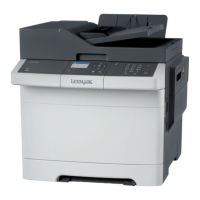During the printing process, the printer follows the six basic EP Process steps to create its output to the page.
1 Charge the photoconductor.
2 Expose the photoconductor with the laser.
3 Develop toner on the photoconductor.
4 First transfer to the ITU, and second transfer to the paper.
5 Fuse the toner to the paper.
6 Clean/erase the photoconductor and the ITU.
In summary, the printer’s controller board receives print data and the command to print. The controller board then
initiates the print process. The controller board is the command center for the EP process and coordinates the various
motors and signals.
The high-voltage power supply (HVPS) sends charge to various components in the EP process. The laser fires on the
photoconductors and alters the surface charge relative to the planed image for each photoconductor. Each
photoconductor rotates past its respective developer roll, and toner is developed on the surface of each
photoconductor. The four separate color images are then transferred to the transfer belt on the ITU as it passes under
the photoconductors. After the image is transferred to the transfer belt, the photoconductors are cleaned and
recharged.
The transfer belt carries the four-colored image towards the transfer rolls. Paper is picked up from the tray and carried
to the transfer roll where the image is transferred from the transfer belt to the paper. The timing of the paper pick is
determined by the speed of the transfer belt.
The paper is carried to the fuser rollers where heat and pressure are applied to the page to permanently bond the toner
to the page. The fuser rollers push the paper into the output bin. The transfer unit is cleaned and the process begins
again for the next page.
Step 1: Charge
During the charge step, voltage is sent from the HVPS to the charge roller beside each of the four photoconductors. In
this printer, the charge roll is part of the photoconductor unit in the print cartridges.
The charge roller puts a uniform negative charge over the entire surface of the photoconductor to prepare it for the
laser beam.
Service tips
• If the surface of the charge roller is damaged (such as a nick or pit), it will cause the charge on the photoconductor
to be uneven. This will cause a repeating mark on the printed page. Check the service manual for the repeating
marks table.
• If the charge roller is severely damaged, the surface of the photoconductor will not be not be properly charged and
heavy amounts of toner will be deposited on the photoconductor. This will cause the printed page to be saturated
with 100% of each color. The imaging basket will need to be replaced sooner.
Step 2: Expose
During the expose step, the laser fires a focused beam of light at the surface of each photoconductor and writes an
invisible image, called a latent image or electrostatic image, for each color.
The laser beam only discharges the surface where the beam hits the photoconductor. This creates a difference in charge
potential between the exposed area and the rest of the photoconductor surface.
7527
Appendix C: Theory of operation
363

